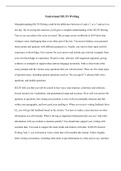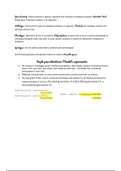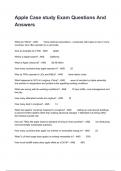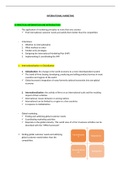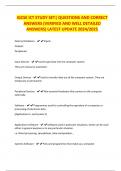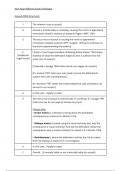HC 1
Introduction to Pathology
Pathology is the study of diseases, whereby a disease is anything abnormal when compared
to the normal state. Normal, in turn, is the most frequent state in a given population. A
disease can be characterized by its symptoms, morphological features and functional
manifestation. The functional manifestation is a consequence of the morphological cause.
Pathology describes a disease based on:
- Epidemiology: incidence and distribution of disease
- Etiology: the cause or underlying root of the problem (e.g. cholera bacterium) and
modifying factors responsible for the initiation and progression of the disease. This
can be a combination of several factors.
- Pathogenesis: the mechanism and progression of disease, including the
cellular/molecular changes giving rise to the abnormalities describing the disease
(e.g. the cholera toxin and diarrhea cascade). Etiology is more why, pathogenesis
more how.
- Symptoms: or manifestations, the signs the organism has of a disease, which may be
morphologically clear or internally present.
- Prognosis: the extent how the disease will probably progress further, what
development or consequences may arise. Important for treatment – for which
etiology and pathogenesis are also essential.
In essence, pathologists use morphologic, molecular and other techniques to define
biochemical and structural or functional changes that occur within cells, tissues or organs.
Cells continuously interact with their environment, adjusting their structure and function
accordingly. Despite their internal milieu being tightly regulated according to homeostasis,
cells are able to adapt in response to physiological stress. If the adaptive demand becomes
too large, the cell endures injury that until certain limits is still reversible. If stress persists,
irreversible injury follows, and cell death occurs. Cell death is a normal and (evolutionary)
essential process needed for e.g. tissue homeostasis or embryogenesis.
Cells, living in a community within multicellular organisms create a niche or optimized
internal milieu also attractive for intruders; the organism having to deal with infectious
diseases. Moreover, though cells work in an organized network with a clear division of tasks,
here and there a rogue cell alters the balance and becomes cancerous.
Cell Injury and Death
A normal cell, one that maintains homeostasis can at any point endure injury, from various
causes:
- Hypoxia or ischemia: this is the most common cause, whereby a reduced blood
supply (ischemia) leads to an oxygen deficit (hypoxia), a lack of essential nutrients
and a build-up of waste products. Reduced blood flow may e.g. occur by arterial
blockage.
- Toxins: these chemical compounds forcefully change and damage a cells internal
milieu.
- Infectious agents: pathogens like bacteria or viruses causes disease by intervening
with regular cellular activity.
, - Immunological reactions: immune reactions damage cells by initiating inflammatory
responses.
- Nutritional imbalances: insufficient or deficit number of proteins starve cells,
damaging them.
- Physical agents: cases of extreme temperature or electric shocks also physically
damage cells.
- Aging: cellular senescence, results in diminished response to stress and the death of
cells.
Most of these injuries described are reversible – the deranged function of a cell, following
an injury, or an altered morphology can return to normal if the damaging stimulus is
removed. Damaged cells swell up. If damaged, energy-dependent ion pumps stop working,
causing an influx of sodium ions, which takes water along with it; the cell swells as fluid
homeostasis is impaired. Whenever oxygen is supplied again, the pumps work and the cell
may recover. Sometimes, also, degenerated organelles or lipids accumulate inside. In other
cases, organelles are altered themselves, like the ER, as this is an active metabolic station
inside the cell that tries to metabolize toxins or other damaging issues; becoming damaged
itself. Misfolded proteins in the ER, those possible to cause cell damage, are kept inside the
ER which tries to correct the mistake. If not possible, the protein is retained. If the causative
agent of the misfolding proteins persists, this builds up in the ER irreversibly damaging the
organelle.
With persistent or excessive noxious exposures, the cell reaches the state of irreversible
damage. Clinicians seek to determine the transition from reversibility to irreversibility,
which is often hard to discover. Irreversibility though is characterized by:
- Inability to restore mitochondrial function
- Loss of structure and function of the plasma/intracellular membranes
- Loss of DNA and chromatin structural integrity.
Cell death manifests itself in two possible ways, one is accidental, and one is programmed:
- Necrosis: accidental, uncontrollable, chaotic cell death as a result from hypoxia or
toxins that cause rapid and severe damage beyond salvage. The cell’s contents are
released extracellularly, which may cause further damage.
- Apoptosis: programmed, controlled, clean cell death that was initiated in an
elimination process or as a result from less severe damage. This type can be
manipulated and is hence therapeutically targeted. This form of cell suicide occurs
after there is a lack of survival signals, which may also occur in healthy tissues. It is
needed in embryological development, to eliminate immune cells, tissue
homeostasis and termination of the inflammatory response. Necrosis is an indication
of a pathologic process, occurring after a killing signal appears.
The loss of function of viability is not closely related in time to morphological changes of cell
injury of death; the former occurs way earlier as opposed to the latter. There may be hours
between losing function and any present morphological features of death.
Regulated elimination and replacement is naturally-occurring; proteins are degraded and
synthesized; parts of cells experience autophagy and are synthesized; cells experience
apoptosis and cell division; tissues are discarded and regrown; an organism dies and
reproduces.



